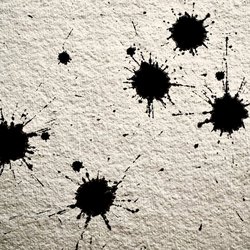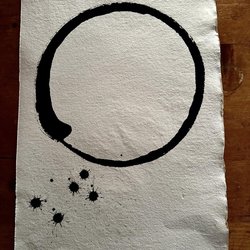Ngak’chang Rinpoche’s is currently creating ‘Sky Signature’ calligraphies. He has had no time for some years — but has been requested by Mé-tsal Wangmo and Ja'gyür Dorje to produce some for those who commit to regular donations to the upkeep of Drala Jong (sGra bLa lJongs / སྒྲ་བླ་ལྗོངས).
Sky Signatures — the calligraphic art of Ngak ’chang Rinpoche
Nam-yig (gNam yig / གནམ་ཡེག་) sky signature is the ‘sky’, signing itself, within itself and out of itself.
The ‘sky of Being’ can ‘sign itself’ in its own dimension. For this to occur, Mind must identify with the sky.
The nature of Mind (chos nyid /ཆོས་ཉིད་) is like the sky. Ideas and images which arise within it, are like clouds. Clouds appear and disappear — but the nature of the sky is unchanged.
When a calligraphy can arise as freely as the play of clouds, then the sky of one’s being has signed its signature.’
Ngak’chang Rinpoche is a Lama of the Nyingma Tradition of Vajrayana Buddhism. Born in 1952 in Hannover Germany—of an English father and German mother—he is the great grand-nephew of Franz Schubert.
He was recognised as the incarnation of gTértön Aro Yeshé by Kyabjé Düd’jom Rinpoche Jig’drèl Yeshé Dorje. Raised in England, he attended Farnham Art School — and later Bristol Art School, where he gained a 1st Class Honours Degree in Illustration (Fine Art painting and print making).
From 1975 he spent eleven years studying in the Himalayas, where he studied thangka painting, and calligraphy – as part of the Lama training (study, practise, and retreat) which he commenced with Kyabjé Düd’jom Rinpoche in 1971 (during a sabbatical year from Art School.)
Written words are sacred in Tibet — because the carry the knowledge of liberation. The scripts Ngak’chang Rinpoche uses are called u-chen and u’mèd.
U’med partially originates from the ancient script: Lha-bab yig-gé (lha babs yig ge /ལྷ་བབས་ཡིག་གེ་) meaning: script-symbols from the sky-expanse.
The calligraphic form of these ‘sky signatures’ are thus both ancient and contemporary. Their spontaneous style was first evolved by Chögyam Trungpa Rinpoche from the influence of his friendship with the Zen Master, Shunryu Suzuki Roshi. Variants of this style were later taken up by Ta’i Situ Rinpoche and other Lamas.
Spontaneous calligraphy is new to the Tibetan tradition – and so has no established form. Each Lama works individually.
Ngak’chang Rinpoche uses a turnip-shaped Japanese brush which holds a considerable quantity of shellac based Indian Ink. The line produced can vary from a hair’s breadth to three inches in width, according to the pressure exerted – and Ngak’chang Rinpoche often uses the full range of possible widths within a single calligraphy – the result being a startling dance of chaos and precision.
Ngak’chang Rinpoche simmers Indian ink over a gentle flame to reduce its water content – thereby increasing the density of the ink. This gives an unusual crispness and shine to the calligraphies – reminiscent of thermographic images, in which resin is employed to produce a raised surface in the printing process.
Ngak’chang Rinpoche uses a ‘heavily loaded brush’ rather than the ‘dry brush’ of the Chinese and Japanese styles. Due to the speed at which the calligraphies are executed, erratic ink droplets explode onto the paper. This causes the ‘splatters’ by which Rinpoche’s calligraphies have become known. The splatters—due to that viscosity of the ink—settle in dramatic patterns on most of his calligraphies.
Ngak’chang Rinpoche uses hand-made rag paper from Sikkim. The paper has various unusual qualities. Being inconsistently absorbent / non-absorbent it is unpredictable in use. It is pressed between thread-bare blankets and therefore not always available – as blankets are now more frequently replaced. This sometimes requires waiting a few years before new supplies of the ‘inferior quality paper’ becomes available. The process of pressing paper between thread bare blankets gives each sheet a unique texture - the roughness of the warp and weft break the edge of brush strokes allowing wide variation in character of each sky signature.











